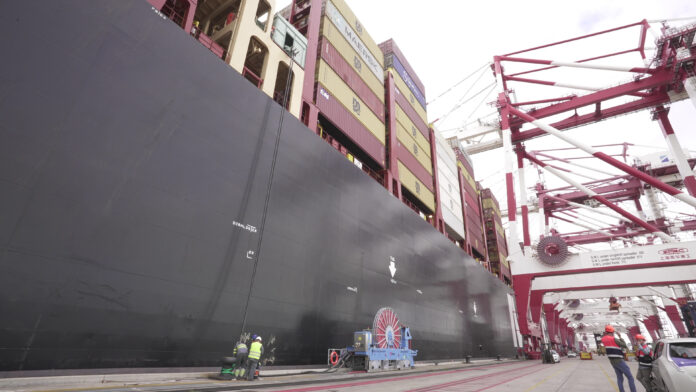For the first time, a ship was able to shut off all its engines while docked at the Port of Barcelona, marking the first emission-free port call for a container vessel.
The new Onshore Power Supply (OPS) system at Hutchison Ports BEST container terminal made this significant step toward decarbonizing port activities possible. The system, which provided 100% renewable energy to the 24,000 TEU container ship MSC Mette during its three-day stay, operated smoothly despite being used for the first time.
The operation occurred at BEST terminal OPS, the first electrical supply system for ships in a Mediterranean box terminal. Completed in August, it includes a cable management system (CMS) designed to bring the connection directly to the ship’s berth without interfering with regular loading and unloading operations. The system is also tailored to meet the specific energy needs of each ship and terminal.
The successful connection on 25 Septtember allowed for a real-world test of the integrated OPS system, demonstrating its compatibility with both ship and terminal operations. The process also confirmed flawless synchronization between the OPS and the ship’s electrical systems.
As each ship’s energy requirements vary, depending on factors like size and refrigerated container count, the OPS system adapts the energy received through the medium-voltage network to match these demands. In this case, the MSC Mette was supplied with 103,200 kWh of power.
The first two years of OPS operation, partially funded by the Sustainable and Digital Transport Support Programme under the Recovery, Transformation, and Resilience Plan, will serve as a pilot phase, collecting data on system functionality and optimizing the integration of ship power supplies into port operations. This knowledge will inform further implementation of the OPS under the Nexigen plan, which aims to electrify the main wharves at the Port of Barcelona over the next five years.
“Connecting a container ship to the electricity grid for the first time is a key step forward in the rollout of the Nexigen plan and the decarbonisation of port activity. As of today, we are effectively already eliminating emissions generated by ship engines, a process that will be greatly increased once we roll out the rest of the OPS thanks to the experience that this pilot test will provide us,” commented Port of Barcelona president Lluís Salvadó.
The Nexigen plan, backed by a US$223 million investment, will progress with the launch of the first OPS at a ferry terminal, set to begin operation this winter. Simultaneously, the plan includes the construction of a new electrical substation, which will support the development of a medium-voltage network across the port. This network will feature an underwater pipeline connecting the Energy Wharf and Adossat Wharf, enabling the electrification of all cruise, ferry, and container terminals by 2030.







